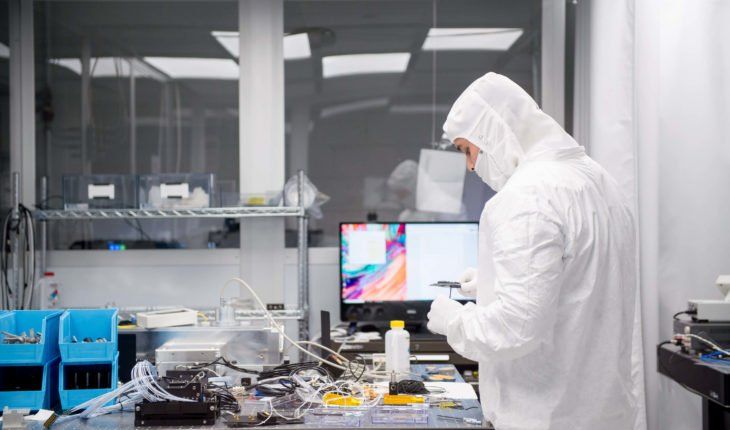
Get the latest international news and world events from around the world.


IonQ Has the Most Powerful Quantum Computers With 79 Trapped Ion Qubits and 160 Stored Qubits
IonQ just made a presentation on two new trapped ion quantum computers with 160 stored and 79 processing qubits. This is more qubits than the best noisy superconducting quantum computers which is currently the Google 72 Qubit Bristlecone processor.
* IonQ systems are at room temperature
* IonQ manipulates ions with magnets and lasers and have software control on mostly FPGA chips.

NASA’s InSight Takes Its First Selfie
First #selfie! I’m feeling healthy, energized and whole. This is me on #Mars. http://go.nasa.gov/2Qn6Pi6&h=AT3Q6ffKt6_9qmkSPTO3bdwJ0GlGXlT…Qbo516oeGQ

NASA to NBA star Steph Curry: Yes, we went to the moon, and we can prove it
NASA has offered to give NBA superstar Steph Curry a tour of one of its lunar labs after the Golden State Warriors guard said on a podcast that he doubts humans landed on the moon.
No, really.
Curry made the head-scratching comment on an episode of the “Winging It” podcast, which posted Monday. According to Bleacher Report, Curry brought up the subject himself during the more than hour-long podcast with fellow NBA players Vince Carter, Kent Bazemore and Andre Iguodala:

Best Bitcoin wallet: Hardware or hosted?
The reader uses the term “digital wallet” to mean a hosted wallet in which a trusted 3rd party holds the private keys, or aggregates the assets of many customers and tracks their individual ownership in their own accounting system, like a traditional bank or broker. In this case, the 3rd party is trusted to maintain security, privacy, and constant, robust user access.
It is possible that the reader may have used the term “digital wallet” to additionally refer to PC and smartphone applications, such as Bitcoin Core, Armory or Electrum. But, these are really personal and private wallets — because they are created and configured by the owner, and only the owner has the private keys. And so, we classify device wallet applications as “personal/private” along with hardware or paper wallets. Type 2: Personal Wallets are Private —but with privacy comes risk!
Wallets are personal if the private keys are generated and stored by the user, either on paper, in their PC or smart phone, on a thumbdrive, in a hardware wallet, or even uploaded to cloud storage. As long as the asset owner holds the keys and securely encrypted any uploaded file that contains the keys, the assets are accessible only with his consent.
So, which wallet class is better for securing cryptocurrency access credentials? Custodial or Personal? Which of these models best fits your needs?- A custodial wallet is like a bank a statement. Your assets are maintained by an exchange, rather than tucked into your mattress. The wallet and keys are not under your control, but the process that governs backup and security is rigorous & standardized. Availability to your heirs is governed by documents and laws.
- A personal wallet is completely controlled by you. The private keys must be stored where you will always find them (in your head, a lock box or an encrypted file that is distributed to family in a way that they will always be able to unlock it!). Ensuring future availability, swift transactions or passing wealth after death requires careful attention to tools, process and a secret.
 2. Deciding Factor
There are few individuals for whom direct and private ownership makes sense. In fact, until this month, it did not make sense for me. I am only now configuring my first hardware wallet. I still trust Coinbase to host and control most of my assets. The reasons boil down to security, forgetfulness, errors, legacy ownership and instant access. The ONLY factor that is arguably better with personal custody & control is privacy.
Due to a lack of education, standards, and definitive best practices, this option makes sense for fewer than 5% of Bitcoin owners. Take me, for example… I have been involved with Bitcoin since the first years of its existence, and have been a Bitcoin educator since shortly after Satoshi’s original bombshell. Today, I am a keynote presenter at blockchain and cryptocurrency conferences. I teach blockchain seminars, design courseware for colleges, and am co-chair of the Cryptocurrency Standards Association and partner in Blockchain Research Council.
Yet, I am only now configuring my first hardware wallet. I still trust Coinbase to host and control most of my cryptocurrency.
How do I know if I am a candidate for full / private control?
Using an exchange hosted wallet service is best for most individuals. But, for some, it makes sense to maintain private, local control of blockchain assets. If all criteria in the bulleted list below applies to you, then local and private ownership might make sense. But if you fail even one criteria, then WAIT! Wait until multisig becomes uniform and ubiquitous — and wait until a larger fraction of society is comfortable with the concept and practice of managing private keys. These are gradually becoming new norms. But, it will take a few more years for the world to become comfortable with an unfamiliar concept: personal control of a decentralized asset. You are a candidate for using a personal wallet if you plan to control and secure your own private keys, and if you meet all conditions listed below. The technical criteria will not be requisite in the future—but they are necessary today, because the market currently lacks simple, standardized, widespread tools and uniform practices for safely securing, accessing and passing on these credentials to your heirs. Do all of these criteria apply to you?
2. Deciding Factor
There are few individuals for whom direct and private ownership makes sense. In fact, until this month, it did not make sense for me. I am only now configuring my first hardware wallet. I still trust Coinbase to host and control most of my assets. The reasons boil down to security, forgetfulness, errors, legacy ownership and instant access. The ONLY factor that is arguably better with personal custody & control is privacy.
Due to a lack of education, standards, and definitive best practices, this option makes sense for fewer than 5% of Bitcoin owners. Take me, for example… I have been involved with Bitcoin since the first years of its existence, and have been a Bitcoin educator since shortly after Satoshi’s original bombshell. Today, I am a keynote presenter at blockchain and cryptocurrency conferences. I teach blockchain seminars, design courseware for colleges, and am co-chair of the Cryptocurrency Standards Association and partner in Blockchain Research Council.
Yet, I am only now configuring my first hardware wallet. I still trust Coinbase to host and control most of my cryptocurrency.
How do I know if I am a candidate for full / private control?
Using an exchange hosted wallet service is best for most individuals. But, for some, it makes sense to maintain private, local control of blockchain assets. If all criteria in the bulleted list below applies to you, then local and private ownership might make sense. But if you fail even one criteria, then WAIT! Wait until multisig becomes uniform and ubiquitous — and wait until a larger fraction of society is comfortable with the concept and practice of managing private keys. These are gradually becoming new norms. But, it will take a few more years for the world to become comfortable with an unfamiliar concept: personal control of a decentralized asset. You are a candidate for using a personal wallet if you plan to control and secure your own private keys, and if you meet all conditions listed below. The technical criteria will not be requisite in the future—but they are necessary today, because the market currently lacks simple, standardized, widespread tools and uniform practices for safely securing, accessing and passing on these credentials to your heirs. Do all of these criteria apply to you?
- You have a comprehensive understanding of cryptography, including the principals of RSA public-key crypto.
- You have practiced multisig decryption for at least a year. For now, you will need to roll-your-own multisig, to ensure that your heirs or executor can access your wealth in the event of death, forgetfulness or incapacitation.
- You have experience and a clear, documented and standardized plan for separately encrypting and distributing your private keys.
- You understand how to implement a hard fork and have the time to do it after any hard fork split.
- You have an exceptional need for privacy or anonymity, and you feel that a custodian is more likely to “sing” in the event of an audit or court order.
- You have a rehearsal plan for testing your multisig recovery and a willing group of trusted friends (most of them younger than you) who can combine their keys to access your wealth.
- After ensuring that encrypted wallet works, is completely secure and is accessible to your heirs, you have replicated it in a sufficient number of places, that you are certain that your heirs will find it after you die, even if it is 90 years in the future.It must not only survive your lifetime, but the knowledge of where to look and *IF* to look, must be certain, even if your home burns down, your cloud accounts have been deleted and/or Google, Amazon, Microsoft & Apple are no longer in business.
Philip Raymond co-chairs CRYPSA, hosts the Bitcoin Event and is keynote speaker at Cryptocurrency Conferences. He advises The Disruption Experience in Singapore, sits on the New Money Systems board of Lifeboat Foundation and is a top writer at Quora. Book a presentation or consulting engagement.

China Launches 1st Mission to Land on the Far Side of the Moon
The first-ever surface mission to the far side of the moon is underway.
China’s robotic Chang’e 4 spacecraft streaked away from Earth today (Dec. 7), launching atop a Long March 3B rocket from the Xichang Satellite Launch Center at about 1:23 p.m. EST (1823 GMT; 2:23 a.m. on Dec. 8 local China time).
If all goes according to plan, Chang’e 4 will make history’s first landing on the lunar far side sometime in early January. The mission, which consists of a stationary lander and a rover, will perform a variety of science work and plant a flag for humanity in a region that remains largely unexplored to date. [China’s Chang’e 4 Moon Far Side Mission in Pictures].

Wait…Maybe the Hippies Weren’t Right
Not surprising I suppose, and also good…to have a kind of counter article soon in the same magazine.
A recent proposal about consciousness is fascinating—but it’s not science.
- By Joshua Tan on December 11, 2018


The Geminid meteor shower is coming to a sky near you Thursday night
There’s a cool doubleheader in outer space this week: In addition to the fly-by of comet 46P/Wirtanen over the weekend, the often spectacular Geminid meteor shower will also make its annual appearance Thursday.
With hundreds of meteors streaking across the night sky, the Geminids are often the best meteor shower of the year. “The reliable Geminid shower counts as one of the year’s best, peppering the nighttime sky with 50–120 meteors per hour at its peak,” noted EarthSky.org.
More good news: The crescent moon will set around 10:30 p.m., leaving the rest of the night moon-free, Astronomy.com said. Observers under a clear dark sky can expect to see an average of two per minute.